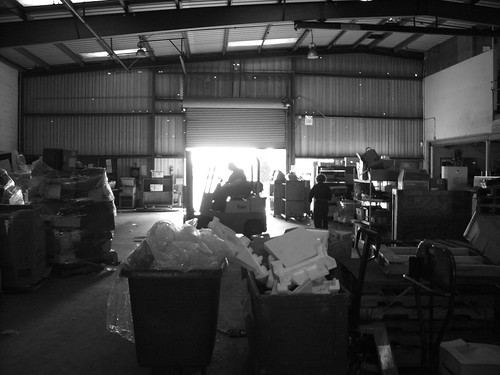Let’s imagine that you set up a non-profit to recycle electronics and divert computers from going directly into landfills or otherwise being destroyed by a grinder. You look for ways to refurbish these components and possibly recombine them into functional computers that go out to areas and institutions that have difficulty obtaining computers. You might even collect some of the vintage electronics that comes through the door and hang on to this stuff because you think it’s cool and somebody may want it someday. Yes, your place looks a bit like a junkyard but it’s one that employs people to do something with the junk you collect. And while you have organized these efforts as a charity, you have figured out how to break even from providing these recycling services and you don’t need donations or government support.

You do all this and then a government inspector drops in one day. This is an inspector from the Department of Toxic Substance Control of the California Environmental Protection Agency . You’ve had inspectors before and the visits have been cordial. Your operation is not unlike the Salvation Army or the Goodwill. You have worked with the DTSC in the past. You think you’re a friend of the environment because you repurpose equipment that would otherwise be waste.
You expect to pass the inspection but no. Instead, you get written up. Perhaps it’s because there’s a new inspector in town with something to prove. No matter, you’ve now been handed a Section 1 violation, which means they can shut you down or make it very hard for you to stay in business. The inspector says that you don’t have a proper inventory of all the parts. The inspector says that you have to get rid of equipment after a year, so you’ll have to clear out your museum of collectibles. This is the letter of the law and you’re expected to follow it. You’re given 30 days to comply.
Now, if this really was you, you might get upset. You’d see all the work you’ve done about to be undone, unravelled. It seems nobody cares that you’re in this mess and the government, which seems to promote and support environmental cleanup, is using narrow interpretations of its regulations to block the operations of a group engaged in precisely this kind of activity.
This scenario is unfolding in Berkeley where the Alameda County Computer Recycling Center and its Director, James Burgett, is having to fight for its life. I presented this scenario in hopes that you might take it as personally as James does and understand why he is very frustrated and angry. If you read his Aftermath Technology blog , you’ll see the emotion. Fortunately, he has a Board of Directors that is supporting him and they are looking into a legal action. But he needs help, just as Jim Mason and the Shipyard needed help this summer when the city of Berkeley threatened to evict them.
James and the ACCRC have been a great friend of Make and especially Maker Faire, where they bring a lot of recycled equipment for makers to salvage for use in Re-Make projects. This year, James organized “Silicon Death Valley,” which was a hearse full of junked computers and other electronics produced in Silicon Valley. We believe it helped create awareness for where a lot of the stuff produced in the valley eventually ends up. James not only brings the equipment, but he also brings a large team of helpers. We’ve been grateful for his participation.
Calling or writing the DTSC is one way you can help James. Ask DTSC supervisors to review the work of this individual inspector and consider whether this action is in the best interest of the environment. You can also write James and show support for his efforts, simply letting him know that others recognize the value of ACCRC to the local community.
At the end of our conversation today, James told me that he was disappointed that the state seemed to be “actively discouraging the highest and best environment reuse.” He said the state pays a firm to destroy the electronics; it doesn’t pay him to refurbish and reuse these components, which is much harder. It doesn’t pay to do this, he admits, but James and the ACCRC have found a way to make it work. I hope James and ACCRC can work their way around this particular roadblock.
Keep track of what happens at the Aftermath Technology blog .
